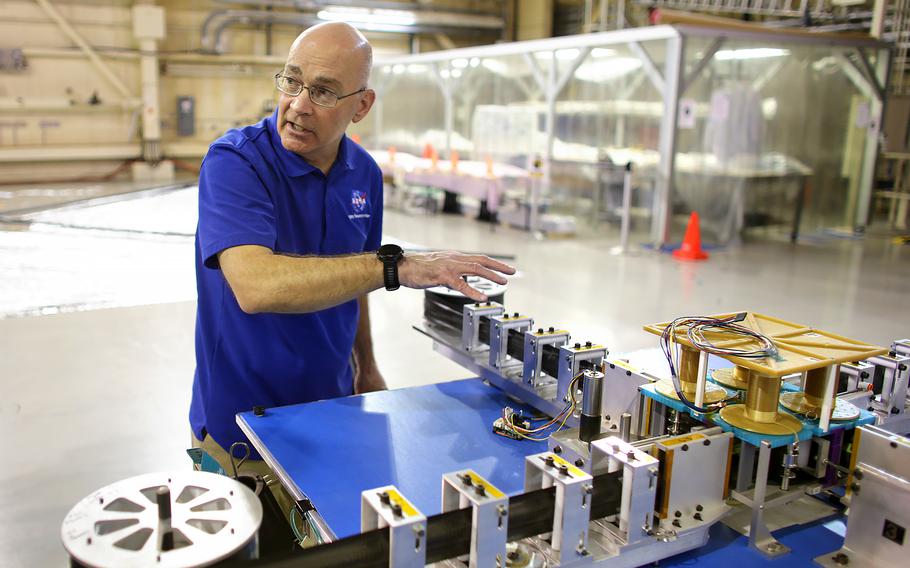
Jay Warren, chief engineer for the ACS3 sail boom subsystem, explains how the advanced composite solar sail system or ACS3’s frame unfolds during deployment Tuesday, April 16, 2024. (Stephen M. Katz, The Virginian-Pilot/TNS)
(Tribune News Service) — A sunlight-propelled satellite floating though space on huge metallic sails sounds like an idea straight from science fiction.
But scientists at NASA Langley Research Center in Hampton have spent five years making the technology a reality and plan to launch a test mission as soon as April 23. If successful, the sail technology could reduce the cost of space missions and make monitoring the sun much easier for scientists.
“It’s really exciting and I’m really excited for what this could demonstrate,” Matthew Chamberlain, head of the structural dynamics branch at Langley, said during a Tuesday media event.
Much like a sailboat harnesses the power of wind, the solar sails use the sun’s light radiation to move through space, Chamberlain said. The pressure of sunlight is imperceptible to humans, but absent Earth’s gravity, the force from light photons bouncing off the reflective sails is strong enough to push the satellite through space.
The technology is able to cram a four-piece, 860-square-foot metallic sail configuration as wide as an apartment into a satellite module the size of a small microwave. The sails are made out of an aluminum-coated membrane 2.5 microns thick — thinner than a human hair, said Jay Warren, chief engineer for the sail system. The sail material, which feels like a very thin party balloon, is so light that a breeze from a door opening and closing can tear it.
The sails are attached to four hollow composite booms, which act like ship masts and hold the sails in place. The 23-foot-long booms are also made from ultra-lightweight materials and can be collapsed and rolled up like a piece of tape. The process of unfolding the booms and sails in space will take about 25 minutes, Warren said.
The upcoming mission has one main goal: to deploy the sail. A secondary objective, Warren said, is to attempt to raise the orbit of the satellite using the sails. This could prove challenging, he said, because the sails are not made to fly in low-Earth orbit.
“So, that’s an extra bonus,” Warren said.
If successful, the technology could be scaled up to support larger sail configurations up to 5,400 square feet using booms up to 54.5 feet in length. Those sails could help send weather instruments closer to the sun to serve as an early warning system for solar storms that can damage sensitive electronics on Earth.
The technology is also cheaper and lighter than rocket propulsion, said Greg Dean, the project’s assembly integration and test lead.
NASA scientists believe the booms could be used to create other structures on the moon and Mars. Additionally, the sail technology could be used by private companies as drag sails to safely take down satellites and other space junk.
NASA plans to launch the mission from a Rocket Lab Electron rocket at the company’s New Zealand launch facility, with the 30-day launch window beginning 5:30 p.m. April 23, based on the U.S. Eastern time zone.
©2024 The Virginian-Pilot.
Visit pilotonline.com.
Distributed by Tribune Content Agency, LLC.